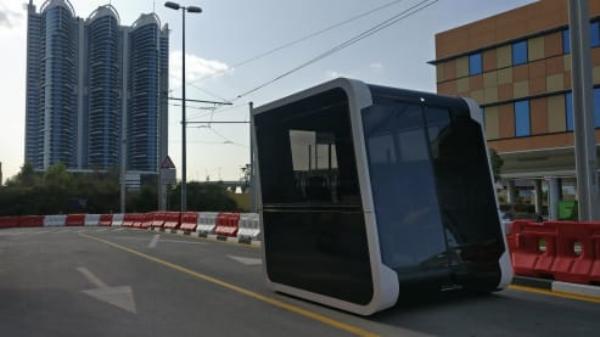Smart pods are driverless cars done right
And a great confirmation of a proposal of mine.

‘Smart pods’ blaze a trail for autonomous public transport in Dubai, says CNN, and it’s easy to see why. These driverless vehicles are slow (20/30 km/hour) and not glamorous by any means. But they can move 10-15 passengers within the the same length as a traditional sedan car, and above all already work today, at much lower costs than more advertised alternatives.
A difficult, but useful coexistence.
One of the obstacles that still thwart large scale adoption of smart pods is “coexistence between human and robotic drivers on the streets, which can lead to unanticipated safety risks”. Part of this problem is that are too safe: “if the sensor sees an unknown object and brakes immediately with full power that can be dangerous”.
In practice, while the smart pods are difficult to integrate with normal traffic, they have proved they are “useful in more confined cases such as university campuses.” And while development and manufacturing of smart pods may be left to the private sector, it is the responsibility of city administrations, say the experts interviewed by CNN, “to provide the framework and infrastructure to accommodate them”. Sometimes, this may mean “entirely redesigning roads and cities”.
And the solution, which is what I said
CNN says that “The more humble charms of short-distance pods are rarely celebrated.” But those charms are not humble. They are appropriate.
The real solution of these problems is real innovation, through appropriate tech and policy, but in the right order. The way to go is not that cities remake themselves to “accomodate” smart pods and make them happy. The way to go is to acknowledge that many, many cities are in dire need of rebuilding themselves anyway, find the money to do that (creating lots of local jobs) and, while redesigning, take into account if and how smart pods may help. But when they can, by far the simplest and better way to solve coexistence is to give those vehicles physically separate lanes. Do that, and the dangers of “too safe” disappears.
This is the solution that is half said, half hinted in that CNN article. And is the same solution I proposed two years ago: the right way to call and manage driverless cars is as small, on-demand trains. Transportation as a service, by smart pods or anything else, needs and makes better cities, not smarter cars.
Who writes this, why, and how to help
I am Marco Fioretti, tech writer and aspiring polymath doing human-digital research and popularization.
I do it because YOUR civil rights and the quality of YOUR life depend every year more on how software is used AROUND you.
To this end, I have already shared more than a million words on this blog, without any paywall or user tracking, and am sharing the next million through a newsletter, also without any paywall.
The more direct support I get, the more I can continue to inform for free parents, teachers, decision makers, and everybody else who should know more stuff like this. You can support me with paid subscriptions to my newsletter, donations via PayPal (mfioretti@nexaima.net) or LiberaPay, or in any of the other ways listed here.THANKS for your support!